Radar Signal Sorting Method Based on Radar Coherent Characteristic
Abstract
1. Introduction
2. Analysis and Modeling of Coherent Characteristics
2.1. Signal Reconstruction and Analysis of Coherent Characteristics
2.2. Frequency-Domain Modeling of Coherent Characteristics
3. Coherent-Feature Extraction
3.1. Spectrum-Image Pretreatment
3.2. Central-Moment-Feature Extraction
3.3. Stability and Adaptability Analysis of the NCM
4. Simulation
4.1. Performance Evaluation of Experiment 1
4.2. Performance Evaluation of Experiment 2
5. Conclusions
Author Contributions
Funding
Conflicts of Interest
References
- Zhang, J.; Wang, F.; Dobre, O.A.; Zhong, Z. Specific emitter identification via Hilbert-Huang transform in signal hop and relaying scenarios. IEEE Trans. Inf. Forensics Secur. 2016, 11, 1192–1205. [Google Scholar] [CrossRef]
- Zhou, Z.W.; Huang, G.M.; Wang, X.B.; Man, X. Specific emitter identification based on joint collaborative representation. Syst. Eng. Electron. 2019, 41, 724–729. [Google Scholar]
- Satija, U.; Trivedi, N.; Biswal, G.; Ramkumar, B. Specific emitter identification based on variational mode decomposition and spectral features in signal hop and relaying scenarios. IEEE Trans. Inf. Forensics Secur. 2019, 14, 581–591. [Google Scholar] [CrossRef]
- Touati, N.; Tatkeu, C.; Rivenq, A.; Thierry, C.; El Hillali, Y. Multi-user radar waveforms based on doubly coded Costas signals. IET Radar Sonar Navig. 2017, 11, 277–284. [Google Scholar] [CrossRef]
- Yuan, Y.; Cui, G.; Ge, M.; Yu, X.; Kong, L. Active repeat jamming suppression via multi-static radar elliptic-hyperbolic location. In Proceedings of the 2017 IEEE Radar Conference, Seattle, WA, USA, 8–12 May 2017; Institute of Electrical and Electronics Engineers Inc.: Seattle, WA, USA, 2017; pp. 692–697. [Google Scholar]
- Yin, L.; Pan, J.; Jiang, Q. A Study on Sorting of Radar-Signal Based on Fuzzy Clustering. Fire Control Command Control. 2014, 39, 52–57. [Google Scholar]
- Zhang, R.; Xia, H.P. Radar Signal Sorting Algorithm of a New K-means Clustering. Mod. Def. Technol. 2015, 43, 136–141. [Google Scholar]
- Li, Y.D.; Xiao, L.Z.; Li, J.M.; Pu, J.F. A method of complex Radar Signal Based on Grid Clustering. Mod. Def. Technol. 2013, 41, 124–128. [Google Scholar]
- Li, T.; Zhang, S.; Ren, Y.; Li, X.; Ren, Y.; Zhang, C. A Lightning location algorithm based on adaptive density clustering analysis. Sci. Technol. Eng. 2018, 18, 53–59. [Google Scholar]
- Xiao, Y.; Wang, H.; Xu, W. Parameter Selection of Gaussian Kernel for One-Class SVM. IEEE Trans. Cybern. 2015, 45, 941–953. [Google Scholar] [CrossRef]
- Ding, L.; Wang, S.; Wang, F.; Zhang, W. Specific emitter identification via convolutional neural networks. IEEE Commun. Lett. 2018, 22, 2591–2594. [Google Scholar] [CrossRef]
- Jin, W.D.; Chen, C.L. Research on Radar Signal Sorting based on Ensemble Deep Learning. J. Syst. Simul. 2019, 9, 1868–1874. [Google Scholar]
- Kishore, T.R.; Rao, K.D. Automatic Intra Pulse Modulation Classification of Advanced LPI Radar Waveforms. IEEE Trans. Aerosp. Electron. Syst. 2017, 53, 901–914. [Google Scholar] [CrossRef]
- Liu, K.; Han, J.B.; Huang, Q.H. Sorting Radar Signal Based on the Improved Resemblance Coefficient and Singular Spectrum Entropy. Mod. Radar 2015, 37, 80–85. [Google Scholar]
- Yildirim, A. Method for estimating the central frequency of phase-coded radar signals. IET Signal Process. 2016, 10, 1073–1081. [Google Scholar] [CrossRef]
- Ren, Y.; Liao, L.; Maybank, S.J.; Zhang, Y.; Liu, X. Hyper spectral Image Spectral-Spatial Feature Extraction via Tensor Principal Component Analysis. IEEE Geosci. Remote Sens. Lett. 2017, 14, 1431–1435. [Google Scholar] [CrossRef]
- Cui, Y.C.; Yang, J.N.; Lv, J.J.; Wang, W. A Fractal Feature Extraction Algorithm Based on Empirical Mode Decomposition. J. Detect. Control. 2016, 38, 104–108. [Google Scholar]
- Tian, C.J.; Pu, Y.W.; Guo, Y.P.; Shi, Y. A Novel feature Extraction Method for the Slice of Ambiguity Function Main Ridge of Radar Signals Based on Graphic Contours. Acta Armamentarii 2018, 39, 2280–2288. [Google Scholar]
- Bai, H.; Zhao, Y.; Hu, D.; Xu, Y. Radar Emitter Recognition Based on Image Feature of Choi-Williams Time-Frequency Distribution. J. Data Acquis. Process. 2012, 27, 480–485. [Google Scholar]
- Yong, Y.W.; Hoon, P.J.; Woo, B.J.; Cheol, K.S.; Hoon, M.N. Automatic feature extraction from jet engine modulation signals based on an image processing method. Radar Sonar Navig. Iet 2015, 9, 783–789. [Google Scholar] [CrossRef]
- Ren, D.F.; Zhang, T.; Han, J. Specific emitter identification based on ITD and texture analysis. J. Commun. 2017, 38, 160–168. [Google Scholar]
- Han, J.; He, M.H.; Guo, L.R.; Wei, Q.Y. Sorting Method Based on Coherent Radar Signal Auto-correlation Function. J. CAEIT. 2015, 2, 204–208. [Google Scholar]
- Ru, X.H.; Liu, Z.; Jiang, W.L.; Huang, Z.T. Recognition performance analysis of instantaneous phase and its transformed features for radar emitter identification. IET Radar Sonar Navig. 2016, 10, 945–952. [Google Scholar] [CrossRef]
- Bai, H.; Zhao, Y.J.; Hu, D.X. Radar Signal Recognition Based on the Local Binary Pattern Feature of Time-frequency Image. J. Astronaut. 2013, 34, 139–146. [Google Scholar]
- Guo, L.R.; He, M.H.; Yu, C.L.; Wang, B.Q. Describe of Frequency Agility Radar Signal Coherent Characteristic. Fire Control Command Control. 2015, 40, 24–27. [Google Scholar]
- Maddala, K.T.; Moss, R.H.; Stoecker, W.V.; Hagerty, J.R.; Cole, J.G.; Mishra, N.K.; Stanley, R.J. Adaptable Ring for Vision-Based Measurements and Shape Analysis. IEEE Trans. Instrum. Meas. 2017, 66, 746–756. [Google Scholar] [CrossRef]
- Vanhoy, G.; Schucker, T.; Bose, T. Classification of LPI radar signals using spectral correlation and support vector machines. Analog Integr. Circuits Signal Process. 2017, 91, 305–313. [Google Scholar] [CrossRef]
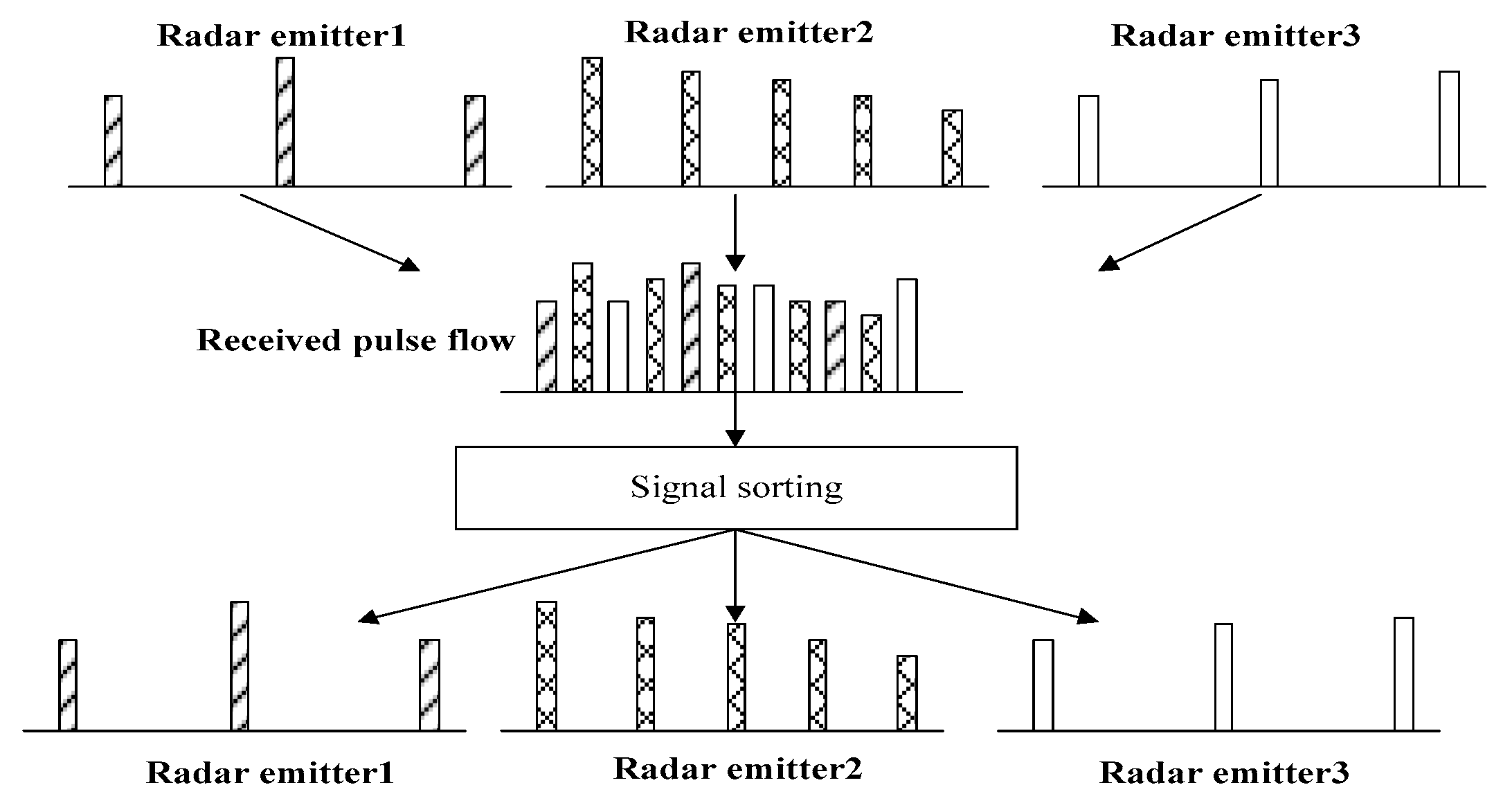

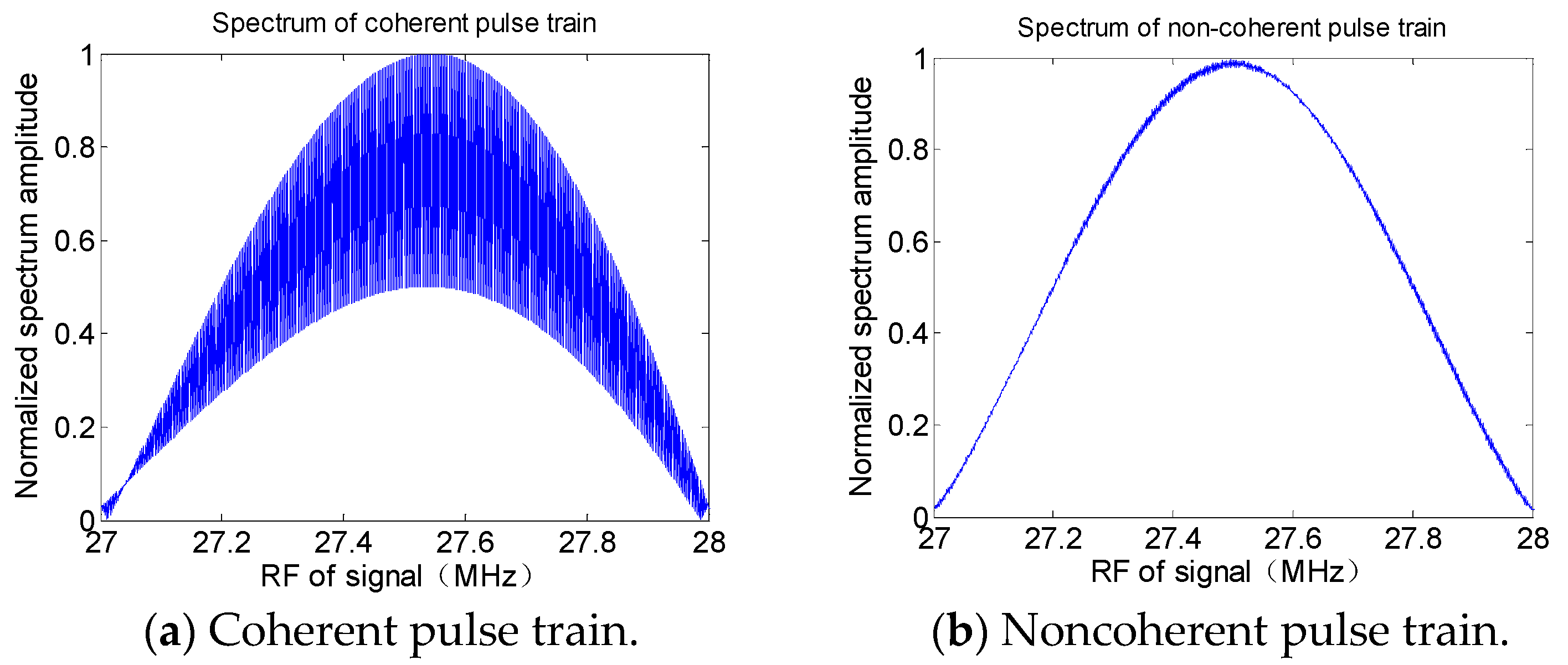

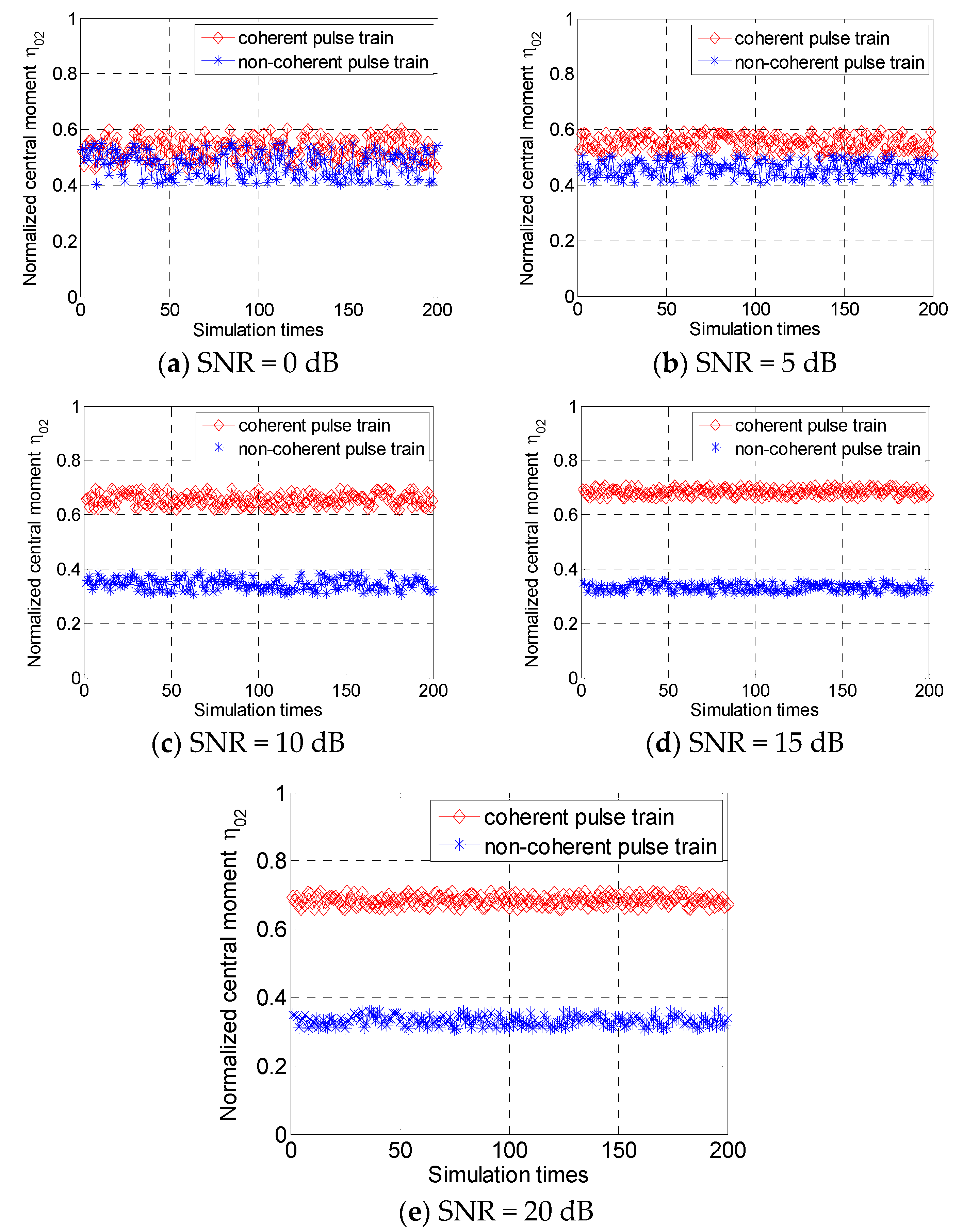
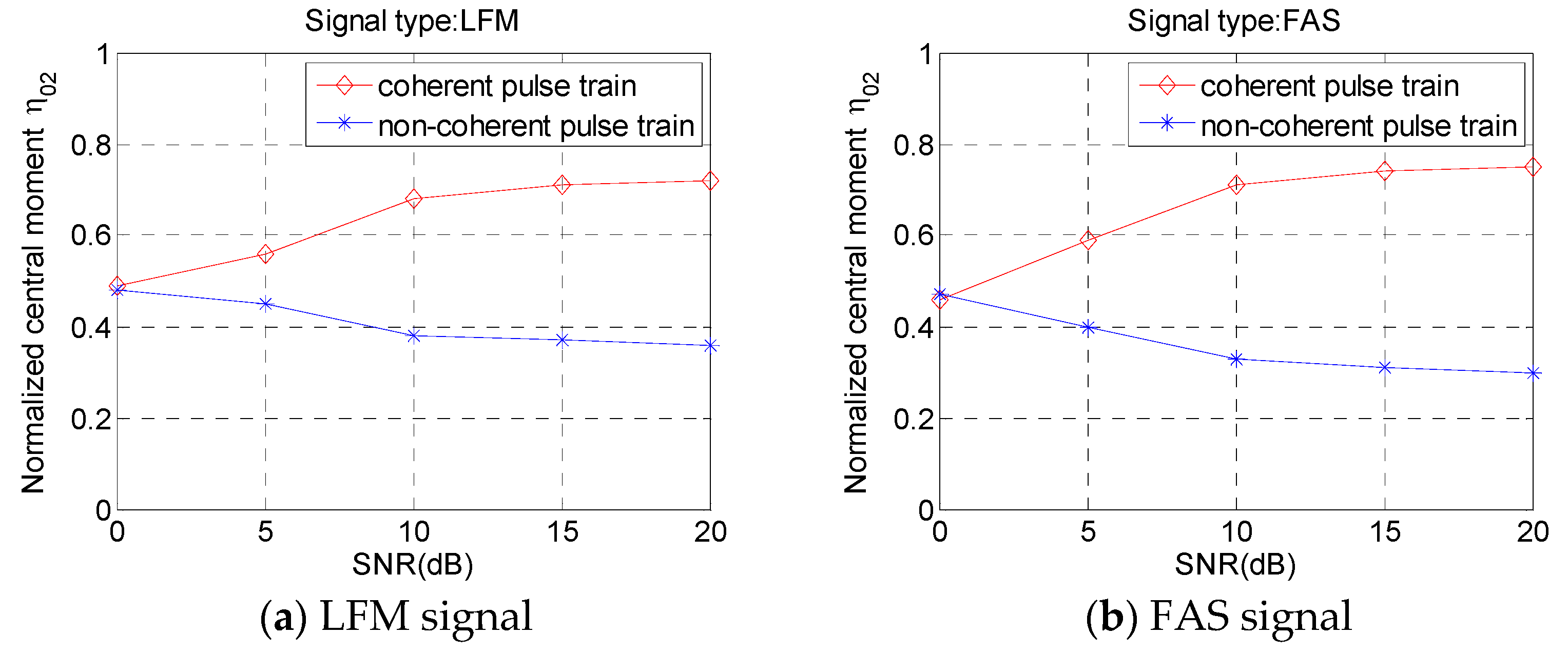
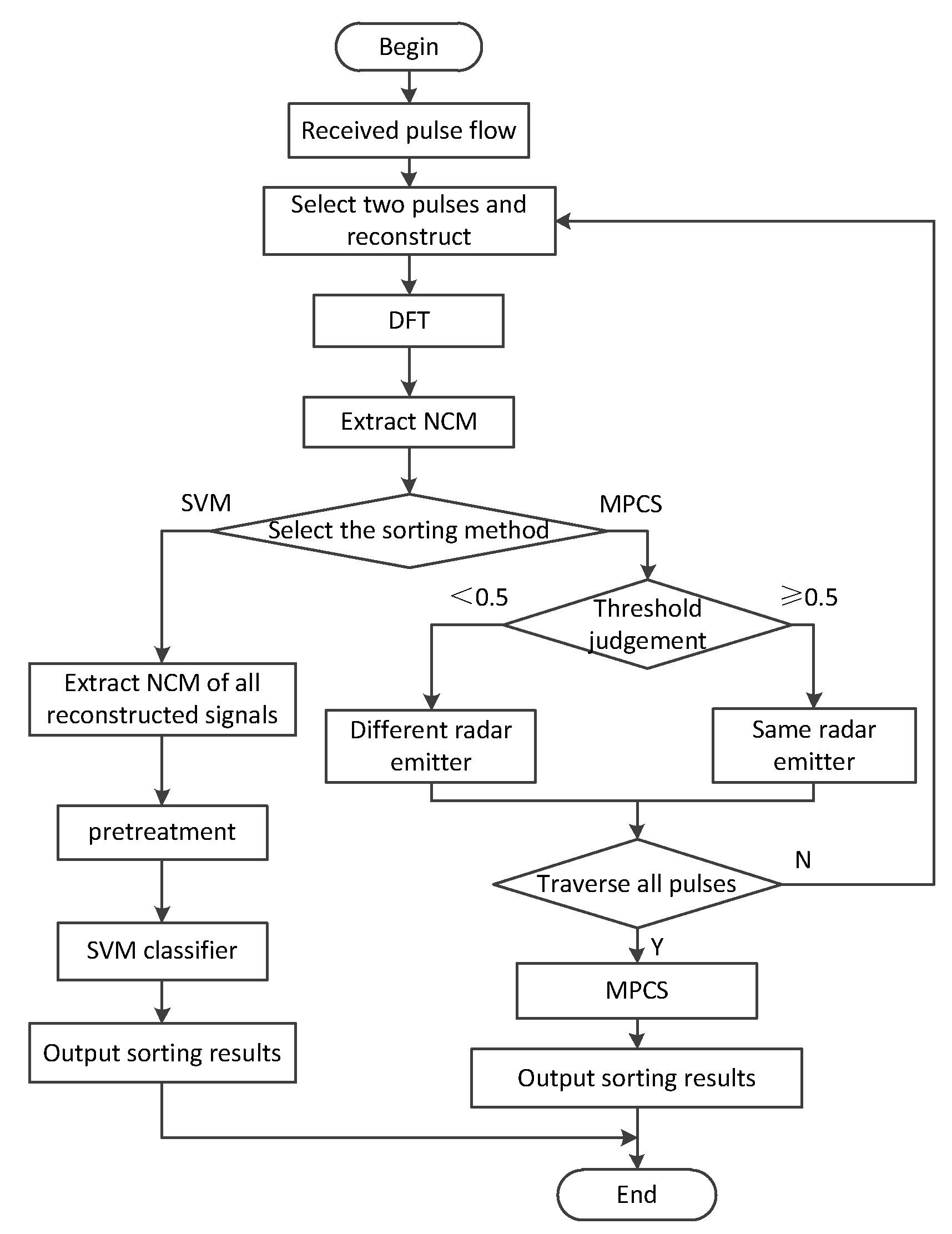

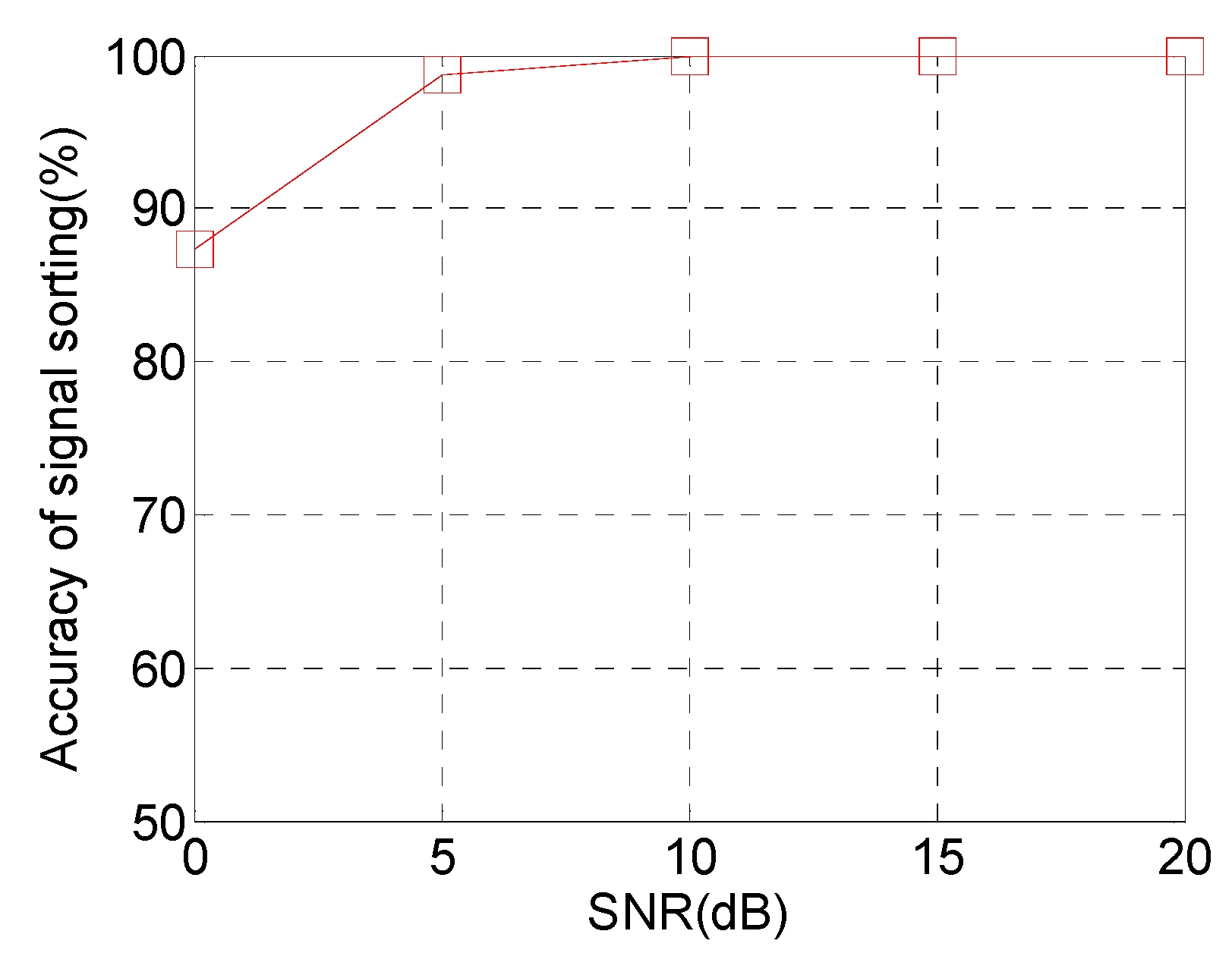

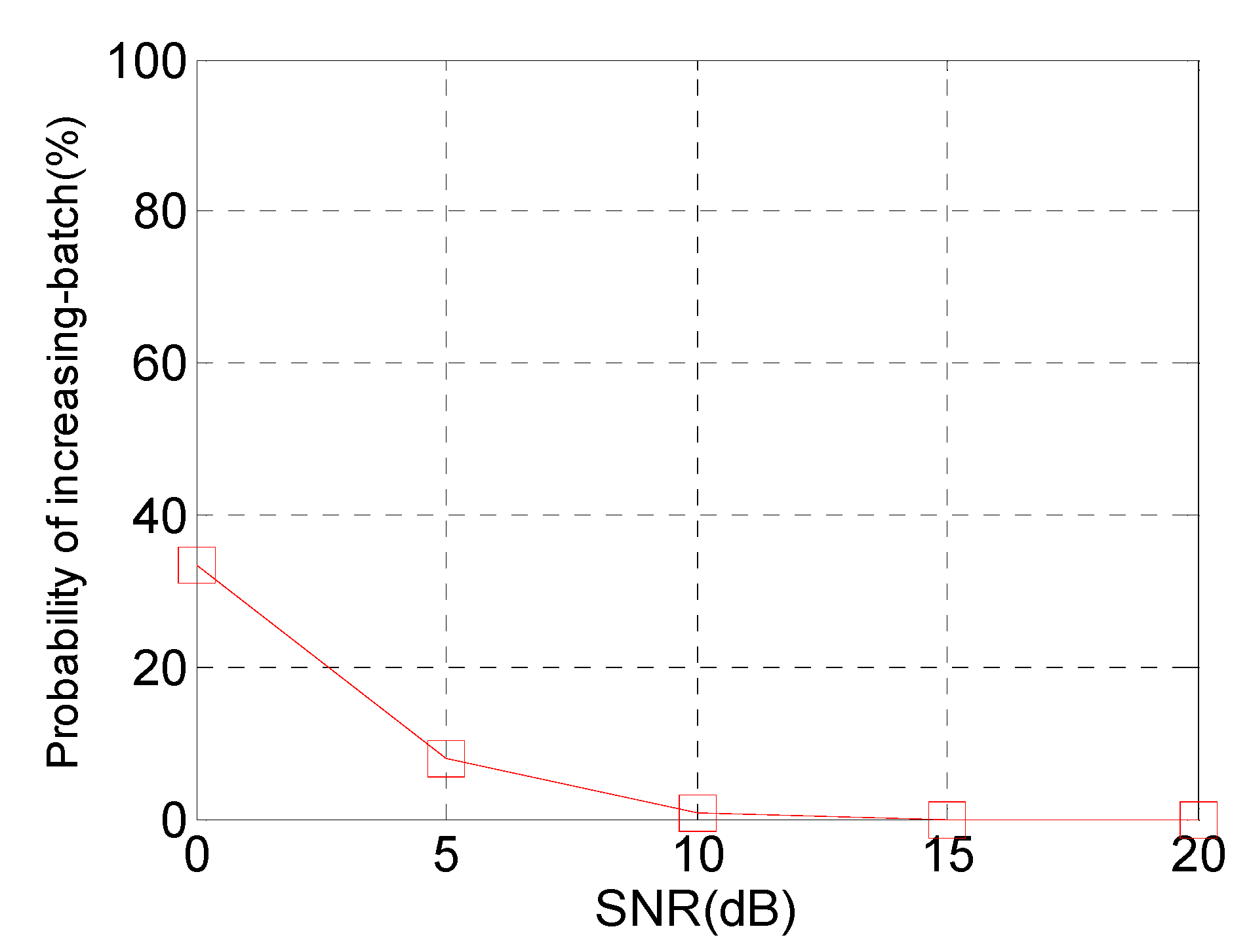
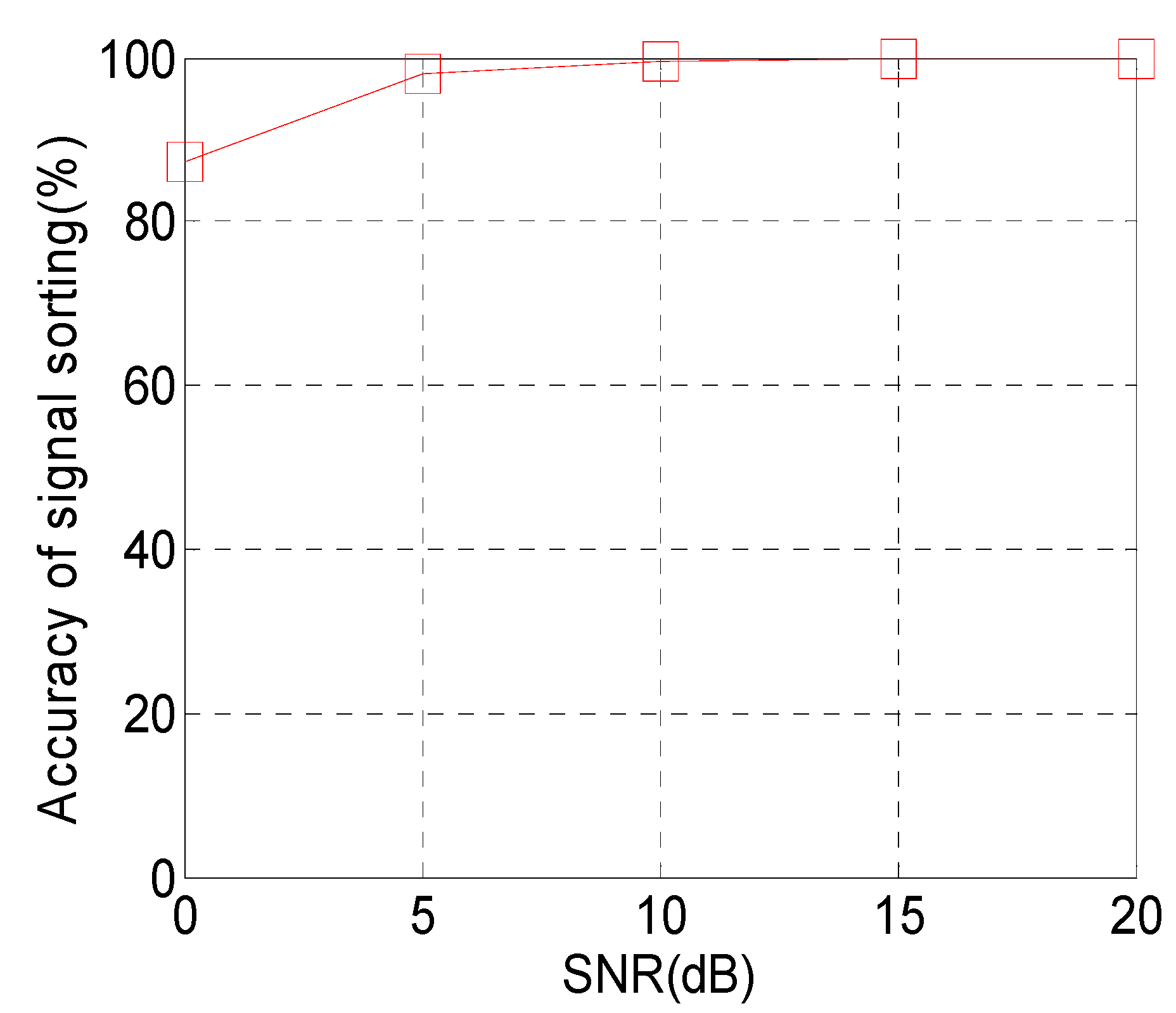
| Pulse Train | PA | RF (MHz) | PW (μs) | PRI (μs) | Fs (MHz) | Coherence |
|---|---|---|---|---|---|---|
| Pulse Train 1 | 1 | 30 | 20 | 50 | 100 | coherent |
| Pulse Train 2 | 1 | 30 | 20 | 50 | 100 | non-coherent |
| Pulse Train | PA | RF (MHz) | PW (μs) | PRI (μs) | Fs (MHz) | Coherence |
|---|---|---|---|---|---|---|
| Pulse train1 | 1 | 30 | 15 | 45 | 100 | coherent |
| Pulse train2 | 1 | 30 | 15 | 45 | 100 | non-coherent |
| Pulse Train | PA | RF (MHz) | PW (μs) | PRI (μs) | Fs (MHz) | Coherence |
|---|---|---|---|---|---|---|
| Pulse train1 | 1 | 10 | 50 | 200 | coherent | |
| Pulse train2 | 1 | 10 | 50 | 200 | non-coherent |
| Emitter | Pulse Train | PA | RF (MHz) | PW (μs) | PRI (μs) | Fs (MHz) |
|---|---|---|---|---|---|---|
| Emitter 1 | Pulse Train 1 | 1 | 27 | 20 | 50 | 100 |
| Emitter 2 | Pulse Train 2 | 1 | 32 | 20 | 50 | 100 |
| Pulse Train 3 | 1 | 27 | 20 | 50 | 100 |
| Emitter | PA | RF (MHz) | AOA | PW (μs) | PRI (μs) | Pulse Number |
|---|---|---|---|---|---|---|
| Emitter 1 | 1 | 30 | 59.8° | 15 | 35,37,39 | 180 |
| Emitter 2 | 1 | 30 | 60° | 15 | 35,37,39 | 180 |
| Emitter 3 | 1 | 30 | 60.2° | 15 | 35,37,39 | 180 |
| Pulse Train | PA | RF (MHz) | PW (μs) | PRI (μs) | Pulse Number |
|---|---|---|---|---|---|
| Pulse Train 1 | 1 | 26 | 20 | 50 | 60 |
| Pulse Train 2 | 1 | 31 | 20 | 50 | 60 |
| Pulse Train 3 | 1 | 36 | 20 | 50 | 60 |
© 2020 by the authors. Licensee MDPI, Basel, Switzerland. This article is an open access article distributed under the terms and conditions of the Creative Commons Attribution (CC BY) license (http://creativecommons.org/licenses/by/4.0/).
Share and Cite
Xue, J.; Tang, L.; Zhang, X.; Jin, L. Radar Signal Sorting Method Based on Radar Coherent Characteristic. Electronics 2020, 9, 1144. https://doi.org/10.3390/electronics9071144
Xue J, Tang L, Zhang X, Jin L. Radar Signal Sorting Method Based on Radar Coherent Characteristic. Electronics. 2020; 9(7):1144. https://doi.org/10.3390/electronics9071144
Chicago/Turabian StyleXue, Jian, Lan Tang, Xinggan Zhang, and Lin Jin. 2020. "Radar Signal Sorting Method Based on Radar Coherent Characteristic" Electronics 9, no. 7: 1144. https://doi.org/10.3390/electronics9071144
APA StyleXue, J., Tang, L., Zhang, X., & Jin, L. (2020). Radar Signal Sorting Method Based on Radar Coherent Characteristic. Electronics, 9(7), 1144. https://doi.org/10.3390/electronics9071144




